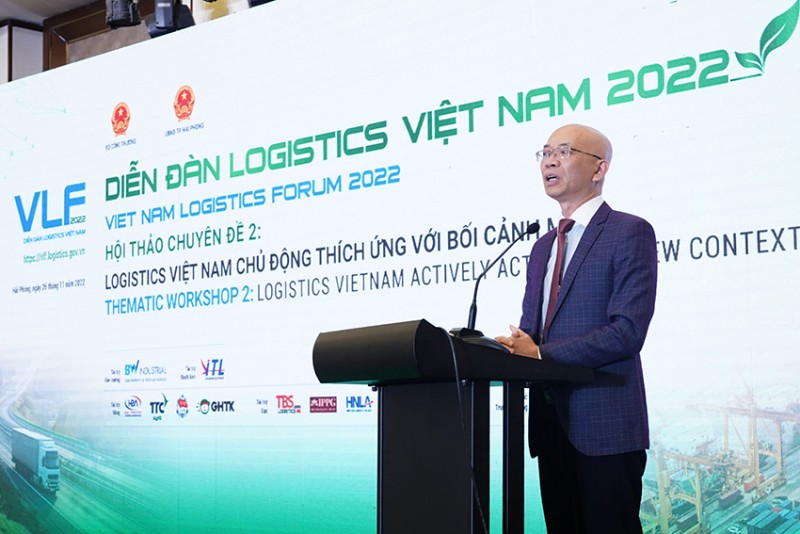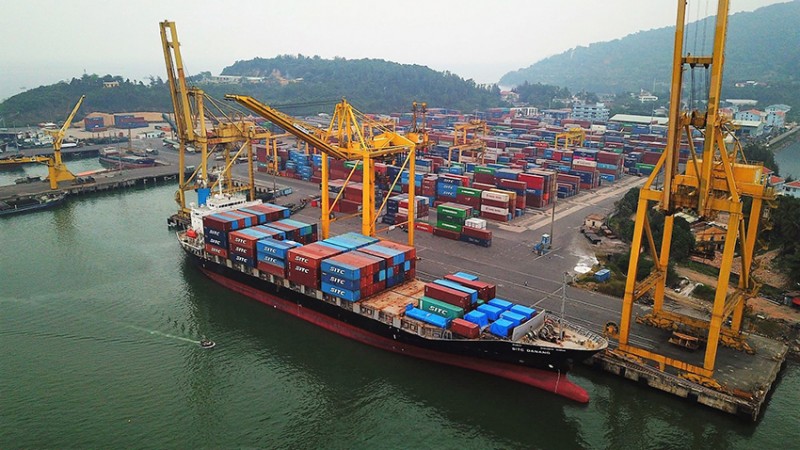 News
News
This is a question asked by many experts at the symposium 2: Logistics Vietnam actively adapts to the new context, within the framework of the Vietnam Logistics Forum 2022.
Logistics Vietnam still has room for high growth
Mr. Tran Thanh Hai - Deputy Director of the Import-Export Department , Ministry of Industry and Trade said: The Logisgics industry is facing many changes in the market, the demand is forecasted to increase in 2024, the arrival of transporters. international transport with a new form of transportation, the application of modern digital technology in transportation... This raises the question of where Vietnam's transport enterprises are located, and how to take advantage of the opportunities that are emerging. gradually appearing before the eyes is a problem that needs to be solved.
 |
| Mr. Tran Thanh Hai- Deputy Director of Import-Export Department, Ministry of Industry and Trade |
Specifically about the current status and potential of shipping, Mr. Vo Duy Thang - Head of Transportation and Maritime Services Department, Vietnam Maritime Administration, Ministry of Transport said: Compared with 2016, The number of Vietnamese transport ships has decreased from 1,267 ships to 1,032 ships, but the tonnage has increased from 7.5 million tons to 10.6 million tons. In terms of fleet structure, Vietnamese shipping ships mainly focus on general cargo and bulk cargo. A small part are container ships, chemical tankers, liquefied petroleum gas and passenger ships.
Currently, Vietnam has more than 500 ship owners, ship management companies. 38 foreign container shipping lines operate in Vietnam, including all the largest shipping lines in the world currently exploiting international market share. Vietnam has 10 container shipping lines operating mainly in the domestic market.
“ According to the results of the study and planning for the development of the seaport system in the 2021-2030 period, with a vision to 2050, it is forecasted that goods through Vietnam's seaports will be about 1,140-1,423 million tons by 2030. In which, container cargo is from 455-559 million tons, equivalent to 38-47 million teu; general, bulk cargo from 521-673 million tons; liquid cargo from 164-190 million tons ”, forecasted Mr. Vo Duy Thang.
He also emphasized: “ With this forecast, the market for shipping is very large, opening up opportunities for Vietnamese and foreign fleets to participate in the Vietnamese market in the coming years. ".
On the basis of actual goods movement, Mr. Bui Van Quy, Deputy General Director of Saigon Newport Corporation, said: The volume of goods in the fourth quarter is forecasted to decrease by 10-15%, which may decrease for a long time to 2023 depending on how active the world market is. However, due to being in the heart of the ASEAN region, especially the impact of new-generation free trade agreements, Vietnam is still a priority partner.
“ It is expected that in the second quarter of 2024 there will be a recovery and upward movement of the economy, leading to a gradual warming of transport activities. In the current time, businesses need to invest in smart logistics, develop green logistics, green ports to catch up and be ready to use when the market grows again , "said Mr. Bui Van Quy.
The above comments are similar to the aviation market, Mr. Dao Trong Khoa, Chairman of Asean Cargo Gateway Company, said: Vietnam has the largest air transport growth rate in Southeast Asia, on average. 9.5% is twice the regional growth rate of 4.7%. Importantly, there are many opportunities for development, but Vietnamese enterprises need to prove their capacity in the context of increasingly fierce competition.
Links to enhance competitiveness
The market of sea transport and air transport is confirmed by experts as there is still a lot of room for growth, however, for sustainable growth, domestic transport enterprises have to face many difficulties. In particular, lack of capital, lack of links, lack of high-quality human resources and not yet catching up with the application of digital technology are the weaknesses that experts have named.
Regarding solutions, with the maritime industry, the representative of the Vietnam Maritime Administration proposed many solutions to build a fleet of ships in the coming time. In particular, continue to promote administrative reform in the field of shipping and promote the application of science and technology to administrative settlement. Continue to review, amend and supplement the system of legal documents on maritime transport, creating a stable and favorable legal corridor to support enterprises to operate effectively. In the immediate future, focus on managing the price of maritime services and managing the operations of container shipping lines in Vietnam. Promote international cooperation in the sea, participate in international conventions, bilateral and multilateral transport agreements and support legal procedures for Vietnamese enterprises to expand their agents abroad.
 |
| Many challenges for Vietnam's logistics industry in the new context |
Exemption from VAT when importing ships for registration of ships flying the Vietnamese flag until the end of 2026; import tax exemption and 50% tonnage fee exemption for ship owners when buying and operating container ships of 1,500 TEU or more or for ships powered by clean energy. Exemption from personal income tax for Vietnamese crew members when working on ships operating on domestic routes.
In this industry, Mr. Bui Van Quy also pointed out a reality: Our container shipping industry is competing with each other, that is, carriers compete with each other on domestic routes. In the current fierce competition, if Vietnam wants to have a powerful fleet, it must join forces and alliances to not compete with each other but compete with the world.
According to a representative of Saigon Newport, Vietnam also needs to build a strong network of agents abroad to compete with international shipping lines. And take the next trip first.
In addition, experts and business representatives also proposed many solutions on: Support for loans secured by assets easier, extending the allowed age of aircraft; attracting investment in building and upgrading airport and seaport infrastructure; invest in the application of a shared platform platform to create linkages and facilitate operations...
Regarding the quality of human resources, Assoc.Prof.Dr. Nguyen Minh Duc, Vice Chairman of the Vietnam Logistics Human Resources Development Association, assessed that the demand for logistics human resources in Vietnam is currently very large, but the quality has not yet met the requirements of businesses.
Regarding the solution to this problem, Vice Chairman of Vietnam Logistics Human Resource Development Association said that it is necessary to promote cooperation between member training institutions in enhancing facilities, training and improving capacity of lecturers, meeting the requirements of training, scientific research and technology transfer in digital transformation and logistics and green supply chain management.
At the same time, continue to innovate and update the training program in the direction of integrating contents and activities to raise awareness and capacity for students in logistics and green supply chain management, digital transformation.
Along with that, it is necessary to coordinate research and propose the development of standards for training programs and professional standards for job positions in the industry. In particular, towards human resources with sufficient knowledge, capacity and attitude to meet the requirements of the industry in new conditions. Develop in-depth, supplementary and updated courses for subjects according to specific tasks to implement green human resource management associated with logistics and green supply chain management.
Enhance coordination and sharing of resources in terms of facilities, textbooks, documents and experts; strengthen cooperation and coordination with businesses and associations to link training, practice, internship and recruitment activities with reality in a practical way, strengthen the leading role of enterprises with development activities. comprehensive development of human resources.